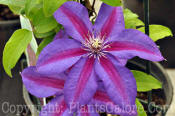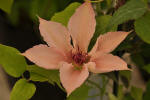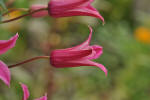|
|
|
 |
|
 |
|
|
|
 |
 The genus,
Clematis, contains a
lot of different species and hundreds of cultivars developed
over the past two centuries. However, they can generally be
divided into 3 groupings based on their growth habit, season of
bloom and flower types. The genus,
Clematis, contains a
lot of different species and hundreds of cultivars developed
over the past two centuries. However, they can generally be
divided into 3 groupings based on their growth habit, season of
bloom and flower types.
Pruning schedules for clematis
also fall into these 3 categories and is covered in our
Care and Maintenance pages.
|
|
 |
|
Group 1: Early-flowering Species and Cultivars |
 Since these clematis flower early in the season,
they do not have time to develop flower buds in the
spring. Therefore, these types all set their flower
buds in the fall and they spend the winter on the
vine. Since these clematis flower early in the season,
they do not have time to develop flower buds in the
spring. Therefore, these types all set their flower
buds in the fall and they spend the winter on the
vine.
Generally, these clematis have single,
bell-shaped or open bell flowers. The blooms are
relatively small ranging from ¾-2 inches in
diameter.
Pruning Group 1
|
|
Late Winter to
Spring Flowering |
|
Name |
 |
Remarks |
Aspect |
Vigor |
Pruning |
| Clematis cirrhosa |
Off-white |
Evergreen |
Any |
Great |
A |
|
Mid to Late
Spring Flowering |
| C. cirrhosa balearicu |
Greenish-yellow |
Evergreen |
Sheltered |
Great |
A |
| C. alpina 'Columbine
Rivis' |
Soft lavender-blue
|
|
Any |
Low |
A |
| C. alpina 'Frances |
Violet-blue |
|
Any |
Moderate |
A |
| C. alpina 'Ruby'
|
Rosy-red |
|
Any |
Low |
A |
| C. alpina 'White Moth'
|
White double |
|
Any |
Low |
A |
| C. armandii 'Snowdrift' |
White scented |
Evergreen |
Sheltered |
Great |
A |
| C. macropetala 'Markham's Pink' |
Soft pink semidouble |
|
Any |
Moderate |
A |
|
C. montana |
Pinkish blue |
|
Any |
Great |
A |
|
|
 |
|
Group 2: Early to Mid Season, Large flowered Species
and Cultivars |
 These clematis bloom
in late spring to early summer. The flowers are born
on side shoots that develop in the early spring. For
many of them, a second flush of flowers appear in
late summer at the tips of the current year's
growth. These clematis bloom
in late spring to early summer. The flowers are born
on side shoots that develop in the early spring. For
many of them, a second flush of flowers appear in
late summer at the tips of the current year's
growth.
The flowers of this
group are usually large and saucer like in shape.
There may be single, double and semi-double blooms
and there are many, many cultivars of this type.
Pruning Time: Prune
this type of clematis before the new growth begins
in the early spring. Remove the dead and damaged
parts of the vine. You can also cut back longer
stems to a flower bud. In the end, you should keep
the pruning to a minimum especially for the large,
double flower types which take more time to develop
on the vine.
Cultivars of double
flowered clematis in Group 2 include 'Multiblue', 'Mrs. P. T. James', 'Belle of Woking' and 'Duchess of
Edinburough'.
Included in this category are popular cultivars of 'The
President' and 'Nelly Moser'. Often, the second
flush of blooms on the double types will produce
single flowers.
Pruning Group 2
|
|
Late Spring to
Early Summer Flowering |
|
Name |
 |
Remarks |
Aspect |
Vigor |
Pruning |
| C. chrysocoma |
Soft pinkish-mauve |
|
Any |
Great |
A |
| C. macropetala 'Lagoon'
|
Deep lavender semidouble |
|
Any |
Moderate |
A |
| C. montana |
white |
|
Any |
Great |
A |
| C. montana 'Elizabeth' |
Pink richly fragrant |
|
Any |
Great |
A |
| C. x vedrariensis 'lighdown'
|
Deep pink |
|
Any |
Great |
A |
|
|
 |
|
Group 3: Late-Flowering Clematis |
All of the late
season flowering clematis bear their flowers on the
current year's growth. Included are several large,
saucer shaped flowers as well as small flowered
cultivars with either single or double blooms. Some
of these are herbaceous species which do not form a
woody stem like most clematis. Their flowers tend to
be single, bell or tubular shaped.
Pruning Group 3
|
|
Late Summer to
Autumn Flowering |
|
Name |
 |
Remarks |
Aspect |
Vigor |
Pruning |
| C.
flammula |
white |
small fragrant |
Not sunless |
Great |
C |
|
C. jackmanii |
|
|
|
|
C |
| C. orientalis |
Thick, orange-yellow |
(orange-peel
clematis) hanging sepals |
Not sunless |
Strong |
C |
|
C. paniculata |
|
|
|
|
C |
| C. rehderiana |
Straw-colored |
bell-shaped |
Not sunless |
Strong |
C |
| C. tangutica
|
Bright yellow |
|
Not sunless |
Strong |
C |
| C. texensis 'Gravetye
Beauty' |
Rich, deep red |
|
Not sunless |
Moderate |
C |
|
C. viticella |
|
|
|
|
C |
|
|
|
|
 |